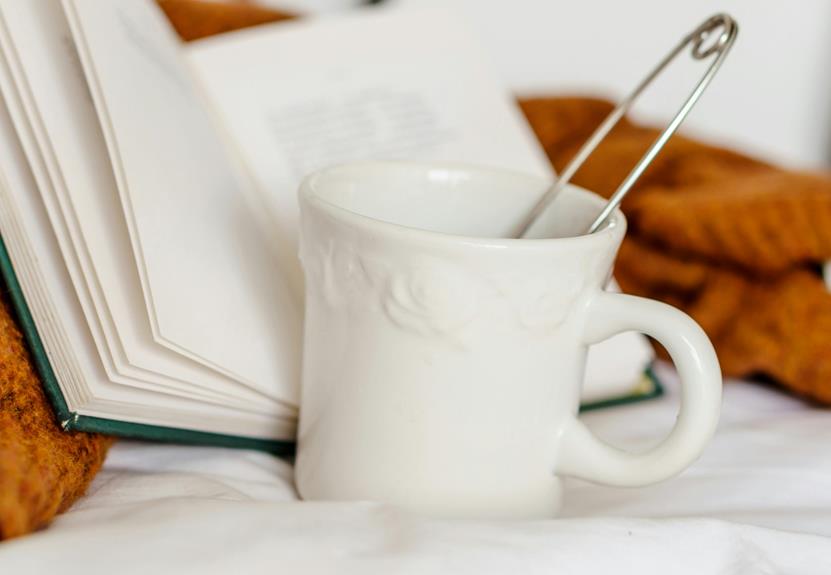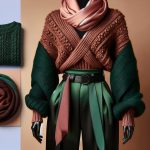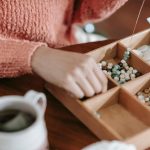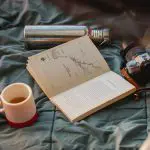If you're looking to add a unique touch to your home decor fabrics, tea staining might just be the perfect solution. This technique not only gives your textiles a lovely vintage feel, but it's also surprisingly simple and requires minimal materials. By using natural fibers like cotton or linen, you can create stunning shades of brown that enhance your space's ambiance. As you explore the process, you'll discover various tips and tricks to achieve the perfect hue, but there are a few essential steps you won't want to overlook. Let's get into the details.
Table of Contents
Key Takeaways
- Choose natural fiber fabrics like cotton or linen for optimal tea absorption and better staining results.
- Pre-wash fabrics with mild detergent and cold water to prepare them for staining.
- Brew strong black tea and soak the fabric, checking every 10 minutes to reach the desired shade.
- Rinse the stained fabric in cold water and hang to dry in a shaded area to prevent fading.
Understanding Tea Staining
Tea staining is a simple and effective method to give your home decor fabrics a warm, vintage look. It's a technique that's been used for centuries, allowing you to transform plain textiles into beautifully aged pieces. By using tea, you can achieve various shades of brown, adding character and charm to items like curtains, tablecloths, or cushion covers.
When you tea stain, you're essentially immersing your fabric in a mixture of brewed tea, which seeps into the fibers. This process not only colors the material but also softens its appearance, creating a more inviting ambiance in your space. The beauty of this technique lies in its versatility; you can control the depth of color by adjusting the steeping time or the amount of tea used.
As you prepare to embark on your tea staining project, remember that the results can vary based on the fabric type and the tea you choose. Experimenting with different fabrics and tea blends can lead to unique outcomes, allowing you to personalize your decor.
Embrace the imperfections that come with this method; they'll give your home a lived-in, cozy feel.
Materials Needed for Tea Staining
To get started with tea staining, you'll need a few basic materials that will help you achieve the perfect vintage look for your fabrics. This process is simple and rewarding, and having the right tools will make it even easier.
Here's a quick list of what you need:
- Tea Bags: Choose black tea for a richer color. The more bags you use, the darker your stain will be.
- Hot Water: You'll need enough to fully submerge your fabric. Boil some water and let it cool slightly before using.
- Fabric: Select cotton, linen, or muslin for best results. Avoid synthetic fabrics, as they won't absorb the tea well.
- Container: Get a large bowl or bucket to hold your tea mixture and fabric. Make sure it's deep enough to allow for even staining.
With these materials in hand, you're ready to dive into the creative process of tea staining.
Experiment with different tea strengths and soaking times to find the look that suits your style best!
Preparing Your Fabrics
Before you start tea staining, it's crucial to choose the right fabric for the best results.
Pre-washing your fabrics can also make a significant difference in how well they absorb the tea.
Let's explore these steps to ensure your project turns out beautifully.
Choosing the Right Fabric
Choosing the right fabric is crucial for achieving the desired look and durability when using tea staining in your home decor. Not all fabrics will absorb tea in the same way, so you'll want to consider a few key factors before diving in. Here are four essential points to keep in mind:
- Natural Fibers: Fabrics like cotton, linen, and silk absorb tea better than synthetic materials. They'll give you richer colors and a more authentic vintage look.
- Weight and Texture: Heavier fabrics tend to hold the stain more evenly, while lighter ones might result in uneven coloring. Choose a texture that complements your decor style.
- Color Base: The original color of the fabric affects the final result. Light-colored fabrics will yield a more pronounced tea-stained effect, while darker ones may not show the color change as vividly.
- End Use: Think about how you'll use the item. For curtains or tablecloths, you might want a more durable fabric, while for decorative pillows, a softer, lighter option could work just fine.
Pre-Washing Techniques
Pre-washing your fabrics ensures they're clean and free from any finishes that might hinder tea absorption. This step is crucial for achieving that beautiful, vintage look you want. Here's how to prepare your fabrics effectively:
- Check the Care Label: Before washing, always read the care instructions. Some fabrics require special handling.
- Use Mild Detergent: Opt for a gentle detergent to avoid any harsh chemicals that could affect the fabric.
- Wash in Cold Water: Cold water helps maintain the fabric's integrity and prevents shrinkage.
Here's a quick reference table to guide you through the pre-washing process:
| Step | Description |
|---|---|
| 1. Care Label | Read instructions to ensure proper care. |
| 2. Detergent | Use a mild detergent for best results. |
| 3. Water Temp | Always wash in cold water to prevent damage. |
Once your fabrics are prepped, you'll be ready to dive into the delightful world of tea staining! This preparation sets the stage for a successful project, letting the tea soak in beautifully.
The Tea Staining Process
To get started with tea staining, you'll need a few essential materials to achieve the desired look.
Once you gather everything, follow a simple step-by-step guide to transform your fabrics.
Let's break down the process so you can create beautiful, aged pieces for your home decor.
Materials Needed for Staining
Gather the essential materials for tea staining, including fabric, tea bags, a large pot, and water. Having the right tools makes the process smoother and more enjoyable. Here's what you'll need:
- Fabric: Choose cotton, muslin, or linen for the best results. Natural fibers absorb the tea better, giving you a rich, even color.
- Tea Bags: Black tea works best due to its strong pigment, but you can experiment with herbal teas for different shades.
- Large Pot: Use a pot that can hold enough water to fully submerge your fabric. A stainless steel or enamel pot is ideal as it won't react with the tea.
- Water: You'll need plenty of water to brew the tea and soak the fabric. Tap water is fine, but filtered water can yield a clearer stain.
Once you gather these materials, you're well on your way to transforming your home decor fabrics into beautifully stained pieces. Keep everything ready, and you'll find the process both simple and rewarding.
Step-by-Step Guide
Now that you have your materials ready, let's walk through the tea staining process step by step. First, brew a strong pot of tea using your black tea bags. Allow it to steep for about 15 minutes to achieve a rich color. While it cools, prepare your fabric by washing it to remove any finishes or chemicals.
Next, fill a large bowl or basin with the cooled tea. Submerge your fabric completely, ensuring it's evenly soaked. The longer you leave it in, the darker the stain, so check every 10 minutes until you reach your desired shade. Once satisfied, rinse the fabric in cold water to set the color.
Finally, hang your fabric to dry in a shaded area. To make this process even easier, here's a quick reference table:
| Step | Action |
|---|---|
| 1 | Brew strong black tea |
| 2 | Soak fabric in tea |
| 3 | Rinse in cold water |
| 4 | Hang to dry in shade |
Follow these steps, and you'll have beautifully stained home decor fabrics ready for use!
Tips for Achieving Desired Shades
Experimenting with different tea types and steeping times lets you control the intensity of the shade on your fabrics. Here are some tips to help you achieve the perfect color for your decor projects:
Choose Your Tea Wisely: Black tea creates rich, dark shades, while green tea offers lighter, more subtle tones. Herbal teas can give you unique colors, like chamomile for a pale yellow or hibiscus for a deep red.
Adjust Steeping Time: The longer you steep the tea, the darker the shade. Start with a 5-10 minute steep for lighter shades, and extend it to 20-30 minutes for deeper colors.
Test on Scrap Fabrics: Before diving into your main project, test different tea combinations and steeping times on scrap fabric. This way, you can see how the color develops and make adjustments.
Dye in Batches: If you want consistency, dye multiple pieces of fabric together. This ensures they'll share the same shade, making your decor look cohesive.
Caring for Tea-Stained Fabrics
How can you ensure your tea-stained fabrics maintain their beautiful hues over time? Caring for them is crucial.
First, always wash your tea-stained fabrics in cold water. Hot water can cause the colors to fade or bleed, ruining your hard work. Use a mild detergent, preferably one that's free of bleach, to keep the tea stains vibrant.
When it comes to drying, air drying is your best bet. Avoid using a dryer, as the heat can dull the colors. Instead, lay your fabrics flat or hang them in a shaded area to protect them from direct sunlight, which can also cause fading.
If you need to iron your tea-stained fabrics, do so on a low setting and place a thin cloth between the iron and the fabric. This prevents any direct heat from altering the color.
Additionally, store your tea-stained items in a cool, dark place when you're not using them, as prolonged exposure to light can diminish their beauty.
Frequently Asked Questions
Can I Use Herbal Tea for Staining Fabrics?
Yes, you can use herbal tea for staining fabrics. It creates unique colors and patterns. Just steep the tea, let it cool, and soak your fabric until you achieve the desired shade. Rinse and dry afterward.
How Long Does the Tea Stain Last on Fabrics?
The longevity of tea stains on fabrics varies. Typically, they can last for months, but factors like washing, sunlight, and fabric type impact durability. To maintain the stain, avoid frequent washing and direct sunlight exposure.
Will Tea Staining Work on Synthetic Fabrics?
Tea staining doesn't work well on synthetic fabrics because they're often treated with chemicals that resist absorption. If you want a vintage look, stick with natural fibers like cotton or linen for better results.
Can I Mix Different Teas for Unique Colors?
Yes, you can mix different teas for unique colors! Experiment with black, green, or herbal teas to create shades that suit your style. Just remember, the results may vary based on steeping time and tea type.
Is Tea Staining Safe for Children's Clothing?
Yes, tea staining is generally safe for children's clothing, especially if you use natural teas without added chemicals. Just make sure to wash the fabric thoroughly before use to avoid any potential allergic reactions.
- How Does Ring Spun Cotton Affect Garment Fit and Shape Retention? - August 13, 2024
- What Are the Challenges in Producing Ring Spun Cotton? - August 13, 2024
- Is Ring Spun Cotton Suitable for Plus-Size Clothing? - August 13, 2024







